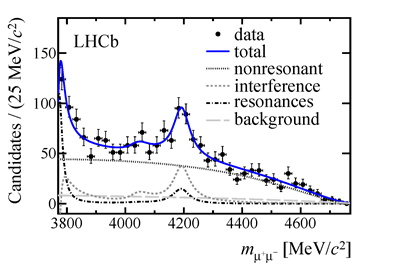The LHCb Collaboration has just presented at the 2013 European Physical Society Conference on High Energy Physics, EPSHEP, Stockholm, Sweden, a first observation of unexpected resonant structure in B+→K+μ+μ– decays. Precise study of this decay could uncover a possible contribution from new physics. This contribution could, however, hide behind the dominant B+→K+μ+μ– decay modes which proceed through the decay of the B+ to a cc resonance (charmonium) and a K+ meson, followed by the decay of the resonance to a μ+μ– pair. To probe for physics beyond the Standard Model it is necessary to remove regions of μ+μ– mass dominated by the resonances. Up to now only the J/ψ and ψ(2S) resonances were taken into account because contributions from resonances with masses above 3900 MeV, where the kaon has a low recoil against the dimuon pair, were thought to be negligible.
The image shows the μ+μ– mass distribution in the low recoil region. What was expected is a smoothly falling distribution, dominated by the non-resonant decay. However, two peaks are clearly visible, one at the low edge corresponding to the decay ψ(3770)→μ+μ– and a wide peak at a higher mass. The mean and width of the wider peak are 4191+9-8 MeV/c2 and 65+22-16 MeV/c2, which are compatible with the so-called ψ(4160) resonance (the name ψ(4160) is misleading, first measurements of the mass of this state gave values lower than it is now known to be). First observations of both the decay B+→ψ(4160)K+ and the subsequent decay ψ(4160)→μ+μ– are reported with statistical significance exceeding six standard deviations.
click the image for higher resolution
This observation is made possible due to quantum mechanical interference between the resonance and non-resonant signal. The resonance and the interference make up 20% of the yield in the low recoil region. This contribution is much larger than expected and in the future, with the large data sets available at LHCb, will need to be taken into acount when searching for new physics in rare decays such as B+→K+μ+μ–.
Read more in the LHCb presentation in Stockholm and in the LHCb paper here.

